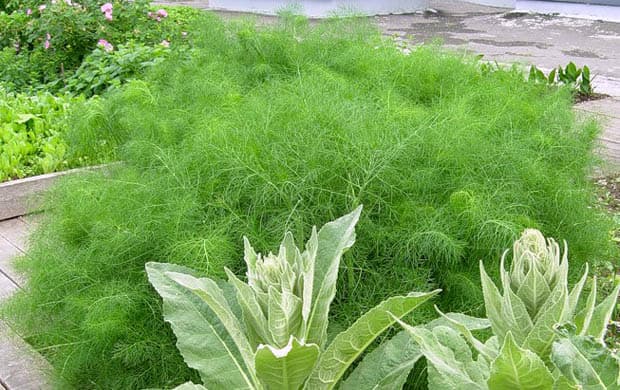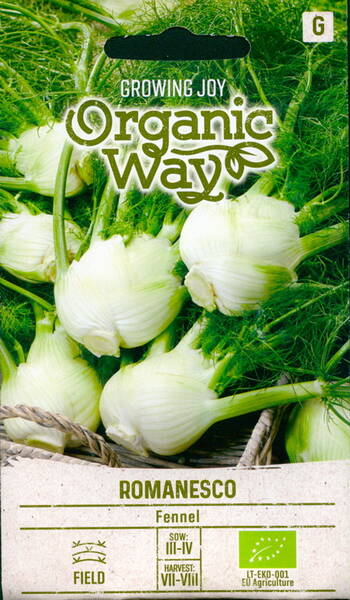Ex Tax: 1.10€
The period from full germination to the formation of a "head of stem" is 53-68 days. The plant is 55-60 cm high. During the flowering period up to 100-110 cm.
The leaves are large, pinnately dissected, the lower ones are petiolate, the upper ones are sessile (from green to dark green), with a slightly waxy coating. The stem is erect, green and strongly branched.
"Head-stem" is white, dense, with small slit-like voids, weighing 200-220 g. The flowers are small, yellow.
They are used fresh and dried as a spice and flavouring addition to soups, meat dishes and vegetables, and fruits are used for canning.
Boiled "head-stems" are used for food, as well as leaves, shoots and roots. Moisture-loving, picky about lighting and soil fertility.
Fennel is a perennial herb of the umbrella family with a height of 150-200 cm.
Distinguish between fennel ordinary and vegetable (or sweet). The latter is grown for the sake of obtaining a thickened part of the stem.
Fennel is placed on fertile loamy soils in open, sunny places.
Propagated by seeds. They are sown in mid-May to a depth of 2 cm, according to the scheme 50 g by 40 cm, at the rate of 0.8-1.0 g / m2.
1,0 g =180-200 seeds.
Care consists of thinning, loosening row spacings and feeding. In vegetable fennel with a thickening of the stem, hilling is carried out.
It is cold-resistant, but without snow, it can freeze out, so in the fall, it is covered with manure or humus. During dry periods, this crop requires watering. Harvesting begins when the plants have reached a diameter of 10 cm.
Agrotechnics.
Fennel loves warmth and light. The growing season is 130-170 days. Not picky about soils. Blooms in the first year from June to August. The fruits ripen from August - early September. Sow in early spring to a depth of 2-4 cm. Seeds germinate at a temperature of + 6 + 8 ° C. Seedlings appear in 12-14 days, tolerate frosts down to -8 ° C. Planting pattern 15x45 cm.
Harvesting and storage of raw materials.
Leaves and heads of cabbage are cut as they grow back. Fennel is harvested for seeds when the fruits on the central umbrella are dry, and on second-order umbrellas are not yet ripe. They are dried and stored in a dry ventilated area. Fruit yield is 0.2-0.4 kg / m2.

Aniseed–flavoured dill–like vegetable, smooth and pure white bulbs used for food. The foliage and seeds are dried and frozen, white bulbs can be baked, boiled or stewed. This vegetable is highly recommended for fish dishes. Seedlings are planted in the rich soil, permeable to water and air, and harvested in late autumn.
Eng.: Common fennel, garden fennel. Suom.: Maustevenkoli, salaattifenkoli, saksankumina, venkoli. Sven.: Sötfänkål. Bot. syn.: Anethum foeniculum L., Foeniculum capillaceum , Foeniculum dulce Mill., Foeniculum foeniculum (L.), Foeniculum officinale All., Foeniculum panmoricum DC., Foeniculum piperitum (Ucria), Foeniculum vulgare Gaertn.
Fennel in appearance resembles dill, and smells like anise. It is highly valued as a medicinal plant. Fennel stimulates appetite, improves digestion.
Fennel is a light-loving, relatively moisture-loving plant. Fennel seeds are sown early in spring or autumn to a depth of 2-4 cm with row spacing of 45 cm. When sown in autumn, they are covered for the winter with humus or manure from freezing.
In spring, seeds germinate slowly over 14-20 days. With an annual crop, fennel is best planted in seedlings after the danger of frost has passed. Seedlings to be 30-35 days old.
4-5 days after emergence, the aisles are loosened to a depth of 5-6 cm. Simultaneously with weeding, they are thinned out, leaving the plant at a distance of 15-20 cm from one another.
In the sprout phase, the fennel is lightly spudded. Fennel leaves can be harvested for greens when they grow up to 20 cm, before flowering - then they are especially tender and fragrant.












